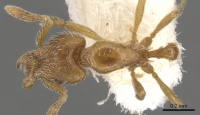Strumigenys anderseni
| Strumigenys anderseni | |
|---|---|

| |
| Scientific classification | |
| Kingdom: | Animalia |
| Phylum: | Arthropoda |
| Class: | Insecta |
| Order: | Hymenoptera |
| Family: | Formicidae |
| Subfamily: | Myrmicinae |
| Tribe: | Attini |
| Genus: | Strumigenys |
| Species: | S. anderseni |
| Binomial name | |
| Strumigenys anderseni (Bolton, 2000) | |
Nothing is known about the biology of Strumigenys anderseni.
Identification
Bolton (2000) - A member of the Strumigenys anderseni-group. S. anderseni and Strumigenys peetersi form a close species-pair within this group, distinguished by the characters listed above and under peetersi. The two together are easily separated from the final member of the group, shattucki, as follows.
S. anderseni and peetersi: Pronotal humeri each with an elongate curved simple projecting hair. Dorsal alitrunk with standing hairs present. Upper scrobe margins and lateral margins of occipital lobes with laterally projecting curved hairs.
Strumigenys shattucki: Pronotal humeri without specialised projecting hairs. Dorsal alitrunk without standing pilosity. Upper scrobe margins and lateral margins of occipital lobes with closely appressed small hairs.
Keys including this Species
Distribution
Latitudinal Distribution Pattern
Latitudinal Range: -12.33333333° to -12.66666667°.
| North Temperate |
North Subtropical |
Tropical | South Subtropical |
South Temperate |
- Source: AntMaps
Distribution based on Regional Taxon Lists
Australasian Region: Australia (type locality).
Distribution based on AntMaps
Distribution based on AntWeb specimens
Check data from AntWeb
Countries Occupied
| Number of countries occupied by this species based on AntWiki Regional Taxon Lists. In general, fewer countries occupied indicates a narrower range, while more countries indicates a more widespread species. |

|
Estimated Abundance
| Relative abundance based on number of AntMaps records per species (this species within the purple bar). Fewer records (to the left) indicates a less abundant/encountered species while more records (to the right) indicates more abundant/encountered species. |

|
Biology
|
Castes
Images from AntWeb

| |
| Paratype of Pyramica anderseni. Worker. Specimen code casent0900161. Photographer Will Ericson, uploaded by California Academy of Sciences. | Owned by NHMUK, London, UK. |
Nomenclature
The following information is derived from Barry Bolton's Online Catalogue of the Ants of the World.
- anderseni. Pyramica anderseni Bolton, 2000: 474, fig. 280 (w.) AUSTRALIA. Combination in Strumigenys: Baroni Urbani & De Andrade, 2007: 115
Unless otherwise noted the text for the remainder of this section is reported from the publication that includes the original description.
Description
Worker
Holotype. TL 2.0, HL 0.50, HW 0.36, CI 72, ML 0.11, MI 22, SL 0.23, SI 64, PW 0.24, AL 0.53. Mostly answering to the description given for peetersi, below, but with the following differences.
1 Dorsum of clypeus with appressed short spatulate hairs.
2 Dorsum of head behind clypeus reticulate-punctate.
3 Ventrolateral margin of head when viewed from above extremely shallowly evenly concave in front of eye.
4 Upper scrobe margin with a row of anteriorly curved narrowly spatulate short hairs; more posteriorly the hairs finer and simple, longer and more strongly projecting.
5 Dorsum of head from posterior margin of clypeus to level of the posterior margins of the eyes densely clothed with very conspicuous appressed spatulate hairs.
6 Hairs on dorsum of head close to occipital margin suberect, short and simple.
7 Hairs on leading edge of scape very narrowly spatulate, not spoon-shaped.
8 Pronotal dorsum with ground pilosity that is simple and blunt apically.
9 Erect hairs on mesonotum simple.
10 Lamella on propodeal declivity with its posterior free margin indented.
Paratype. TL 1.9, HL 0.48, HW 0.36, CI 75, ML 0.10, MI 21, SL 0.22, SI 61, PW 0.24, AL 0.52.
Type Material
- Holotype, worker, OSS Study Site D3, Kakadu National Park, Northern Territory, Australia, Andersen,A.N., ANIC32-002097, Australian National Insect Collection.
- Paratype, 2 workers, OSS Study Site D7, Kakadu National Park, Northern Territory, Australia, The Natural History Museum.
References
- Baroni Urbani, C. & De Andrade, M.L. 2007. The ant tribe Dacetini: limits and constituent genera, with descriptions of new species. Annali del Museo Civico di Storia Naturale “G. Doria” 99:1-191.
- Bolton, B. 2000. The ant tribe Dacetini. Memoirs of the American Entomological Institute. 65:1-1028. (page 474, fig. 280 worker d*Heterick, B.E. 2021. A guide to the ants of Western Australia. Part I: Systematics. Records of the Western Australian Museum, Supplement 86, 1-245 (doi:10.18195/issn.0313-122x.86.2021.001-245).
escribed)

